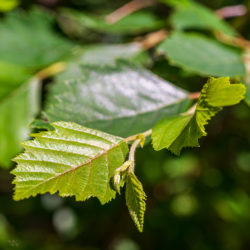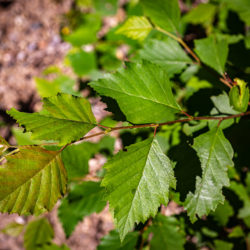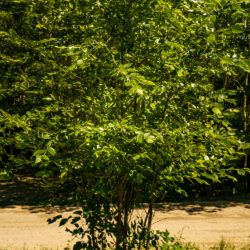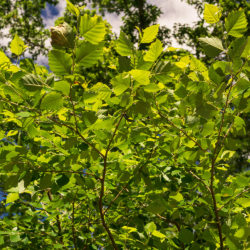Etymology
Betula is Latin for tree of thin and peeling bark, or tree whose “bark is used for writing upon”; lenta is Latin for pliable, a reference to the wood of this birch being exceptionally strong and flexible.
Native Habitat
Woodlands with slightly acidic, rich, moist, well-drained soil.
Garden Uses
Considered a pioneer species (one of the first to appear in recently disturbed sites or newly established woodland), cherry birch grows quickly but is easily stressed by summer heat and high humidity. Useful in naturalized or woodland settings as a specimen or for grove plantings. Cherry birch will add interest to the native woodland garden while attracting butterflies, moths, pollinators, small mammals and songbirds. Cherry birch is considered a deer resistant tree. Its beautiful golden yellow leaves will brighten even the cloudiest fall day. Prune for shaping only after sap has stopped flowing in summer.
Overview
An eastern North American native deciduous tree, it typically grows from 50-75’ with brownish-black, cherry-like, scaly bark, reddish-brown stems, and visible lenticels, similar to a cherry tree in appearance. The young tree is conical in shape becoming more oval in maturity. Cherry birch is an aromatic tree with a rounded crown of spreading branches and scent of wintergreen in crushed twigs and foliage.
Leaves and Stems
Leaves emerge after catkins and are oblong or ovate, 2-4 inches long. Leaf type is simple, margin is serrated and leaves are alternate on the stem. Remaining smooth throughout their growth cycle, the leaves are dark green, changing to golden-yellow in the fall. Bark begins dark and shiny resembling black and matures to dark and scaled or plated. Unlike other birches, bark is not generally spontaneously exfoliating. Twigs and foliage are both aromatic of wintergreen, containing an oil that is identical in taste, fragrance, and chemical composition to the oil from the wintergreen plant.
Flowers
The flower is a catkin that appears before leaf emergence. The bloom color is green tinged with red. Flowers are wind pollinated and monoecious (both male and female flowers on the same tree). Male catkins develop in summer and winter over in groups of 1-3 at the tips of 1-year-old twigs, hanging 3/4"-1" long. Female catkins are erect, cylindrical, wider, and shorter (1/2"-3/4" long) and grow from new, spur-like lateral twigs within the leaves of the same branches as the males.
Fruit/Seed
Female catkins become oval, cone-like clusters about 1" long. When cones ripen (turning brown and dry), they break apart revealing 2 very small winged nutlets, each around 1/8" long, which dry from green to tan or brown.
Wildlife Associates
Cherry birch is a larval host for many insects and butterflies including mourning cloak, dreamy duskywing and Eastern tiger swallowtail. Many moths also use cherry birch as a host plant. Birds eat the ripened seeds. This is an important pollinator host/food source species. This birch is uniquely resistant to the bronze birch borer.
Propagation
Cherry birch flowers are wind pollinated. The tree self-propagates by dropping its ripened or mature nutlets throughout the winter. As with other birches, collect catkins directly into a bag while they are still green enough to hold together. Germination may be facilitated via exposure to light, followed by shallow planting. One month of cold stratification may be an effective alternative to light treatment. Seeds have a lower viability rate than some birch species.
Ethnobotanical Uses
Native American tribes used the bark of cherry birch for its medicinal properties. The cherry birch may be tapped for syrup akin to sugar maple and has been used in the making of birch beer, but the sap is less dense and more copious, making it difficult to harvest economically. The tree was historically used as the source of oil of wintergreen by settlers and was decimated in the lower Appalachian region during the commercial processing of the strongly scented oil used to flavor medicine, toiletries and candy. This oil is now produced synthetically. The wood of this species is one of the most dense of birches. While difficult to work, it ages to a deep color similar to mahogany. It is also desirable as firewood.
Sources
Lady Bird Johnson Wildflower Center
North Carolina Extension Gardener
Yale University, Nature Walk: Black birch
Plant Profile by Ivonne Vazquez & Kate O'Dell




